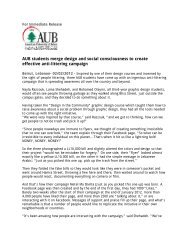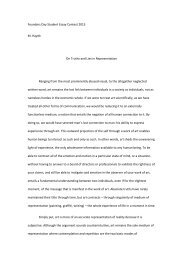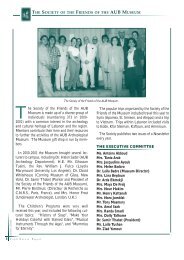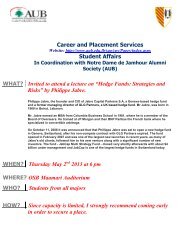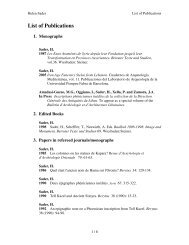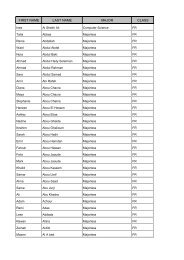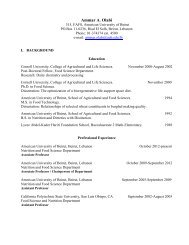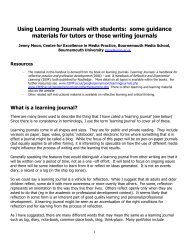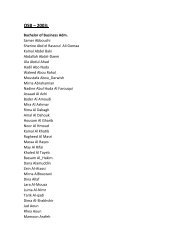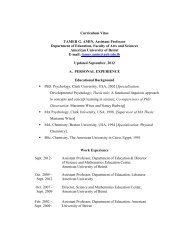Faculty of Agricultural and Food Sciences - American University of ...
Faculty of Agricultural and Food Sciences - American University of ...
Faculty of Agricultural and Food Sciences - American University of ...
You also want an ePaper? Increase the reach of your titles
YUMPU automatically turns print PDFs into web optimized ePapers that Google loves.
AMERICAN UNIVERSITY OF BEIRUT<br />
FACULTY OF AGRICULTURAL AND FOOD SCIENCES<br />
STRATEGIC PLAN<br />
2007-2012<br />
February 2007
INTRODUCTION<br />
This strategic planning report is the outcome <strong>of</strong> a process that was initiated in April 2005<br />
<strong>and</strong> completed in February 2007.<br />
The strategic planning process started under Dean Nuhad Daghir <strong>and</strong> a draft strategy<br />
document was circulated to the <strong>Faculty</strong> in June 2006. The process <strong>of</strong> revisiting the draft<br />
strategy was initiated by Dean Nahla Hwalla following her appointment in September<br />
2006. Revision <strong>of</strong> the strategy was led by Dr. Shady Hamadeh who was appointed<br />
Associate Dean for Strategic Planning. In addition, the Strategic Planning committee<br />
appointed by Dean Daghir was exp<strong>and</strong>ed by Dean Hwalla to include all programs in<br />
FAFS. Revision <strong>of</strong> the strategic plan involved consultations with departments, students <strong>and</strong><br />
staff, inputs from the strategic planning committee, <strong>and</strong> a <strong>Faculty</strong> retreat (January 24,<br />
2007).<br />
The exp<strong>and</strong>ed strategic planning committee is composed <strong>of</strong> the following members:<br />
o Dr. Nahla Hwalla, FAFS Dean<br />
o Dr. Malek Batal (Nutrition)<br />
o Dr. Muhammad Farran (Animal <strong>Sciences</strong> <strong>and</strong> AREC director)<br />
o Dr. Zeina Kassaifi ( <strong>Food</strong> Science)<br />
o Dr. Jala Makhzoumi (L<strong>and</strong>scape Design, Coordinator <strong>of</strong> LDEM)<br />
o Dr. Salma Talhouk (Plant <strong>Sciences</strong>)<br />
o Dr. Rami Zurayk (L<strong>and</strong> <strong>and</strong> Water Resources)<br />
Logistical <strong>and</strong> administrative assistance was provided by Ms. Tharwat Haddad (Dean’s<br />
Office) <strong>and</strong> Ms. Lina Jaber (Research Assistant Animal <strong>Sciences</strong>). Mr. Ziad Moussa<br />
(Research Associate, ESDU), attended parts <strong>of</strong> the planning meetings by invitation, helped<br />
in the compilation <strong>of</strong> last draft <strong>and</strong> facilitated discussion groups during the retreat.<br />
ii
TABLE OF CONTENTS<br />
1. Mission Statement .......................................................................................................... 4<br />
2. FAFS Major accomplishments during the last three years ............................................. 4<br />
2.1. Introduction <strong>of</strong> New Programs ........................................................................... 4<br />
2.2. Broadening the Student <strong>and</strong> the <strong>Faculty</strong> Body ................................................... 4<br />
2.3. Consolidating the Leading Role <strong>of</strong> FAFS in Research <strong>and</strong> Development<br />
(R&D) ................................................................................................................ 5<br />
2.4. Initiating Collaborations <strong>and</strong> Partnerships with Regional <strong>and</strong><br />
International Academic <strong>and</strong> Research & Development Institutions ................. 6<br />
2.5. Achieving Financial Sustainability .................................................................... 7<br />
2.6. Upgrading <strong>of</strong> the Research <strong>and</strong> Teaching Facilities in Beirut <strong>and</strong> AREC ........ 8<br />
3. External Trends <strong>and</strong> Influences ...................................................................................... 8<br />
3.1. The “Macro” Framework ............................................................................................ 8<br />
3.2. The Sectoral Framework .................................................................................... 8<br />
4. Summary Analysis <strong>of</strong> Strengths, Weaknesses, Opportunities, <strong>and</strong> Threats ................... 12<br />
4.1. Strengths ............................................................................................................. 12<br />
4.2. Weaknesses ........................................................................................................ 12<br />
4.3. Opportunities ...................................................................................................... 13<br />
4.4. Threats ................................................................................................................ 13<br />
6. Student Learning Outcomes ........................................................................................... 14<br />
6.1. The B.Sc. in Agriculture Program...................................................................... 14<br />
6.3. The Veterinary Science Program Learning Outcomes ....................................... 15<br />
6.4. Educational Objectives <strong>of</strong> the L<strong>and</strong>scape Design <strong>and</strong> Eco-Management<br />
Program ............................................................................................................. 16<br />
6.5. Educational Objectives <strong>of</strong> the <strong>Food</strong> Science <strong>and</strong> Management Program .......... 16<br />
6.6. The Graduate Program ....................................................................................... 17<br />
8. Summary <strong>of</strong> Key Performance Indicators (Initiative number defined<br />
according to Planning Template in section 10) ................................................ 18<br />
9. Summary <strong>of</strong> Strategic Initiatives .................................................................................... 20<br />
Major Initiatives for the coming 3-5 years (Initiative number defined<br />
according to Planning Template in section 10) ................................................. 20<br />
10. Planning Template ........................................................................................................ 24<br />
11. Mechanisms <strong>and</strong> Activities to secure <strong>Faculty</strong>/Staff Input in the Planning Process...... 27<br />
12. Mechanisms <strong>and</strong> Activities to Foster Interdisciplinary Programs ................................ 27<br />
13. Schedule <strong>of</strong> Strategic Performance Reviews ................................................................ 27<br />
14. Other considerations: FAFS Road map 2006 - 2015 .................................................... 27<br />
iii
1. Mission Statement<br />
The mission <strong>of</strong> the FAFS is to promote <strong>and</strong> disseminate knowledge through higher<br />
education <strong>and</strong> research in food <strong>and</strong> agriculture, nutrition <strong>and</strong> dietetics, l<strong>and</strong>scape,<br />
environment <strong>and</strong> natural resource management, <strong>and</strong> community <strong>and</strong> rural development<br />
as a basis for sustainable improvement in the livelihood <strong>of</strong> people throughout Lebanon,<br />
the Middle East, <strong>and</strong> the world.<br />
2. FAFS Major accomplishments during the last three years<br />
2.1. Introduction <strong>of</strong> New Programs<br />
During the past few years FAFS added to the existing undergraduate degrees in<br />
Agriculture <strong>and</strong> Nutrition <strong>and</strong> Dietetics new programs, namely, L<strong>and</strong>scape Design <strong>and</strong><br />
Eco-Management <strong>and</strong> <strong>Food</strong> Science <strong>and</strong> Management. A BSc. degree in Veterinary<br />
<strong>Sciences</strong> has been also submitted for approval.<br />
At the Graduate Studies level, FAFS <strong>of</strong>fers degrees in 10 disciplines (agricultural<br />
economics, animal sciences, food technology, irrigation, mechanization, nutrition, plant<br />
protection, plant science, poultry science, <strong>and</strong> soil science). In 1998, an interfaculty<br />
M.Sc. degree was introduced by FAFS in Environmental <strong>Sciences</strong> with emphasis on<br />
Ecosystem Management.<br />
The School has also applied for a PhD degree in Nutrition. The anticipated Ph.D. in<br />
nutrition program will address the severe shortage in qualified pr<strong>of</strong>essionals in<br />
Lebanon <strong>and</strong> the Middle East. The program will <strong>of</strong>fer specialization in community<br />
nutrition <strong>and</strong> clinical nutrition.<br />
FAFS <strong>of</strong>fers its students possibilities to combine a minor in <strong>Food</strong> <strong>Sciences</strong> with a<br />
major in nutrition or agricultural sciences <strong>and</strong> vice versa.<br />
2.2. Broadening the Student <strong>and</strong> the <strong>Faculty</strong> Body<br />
The academic changes at FAFS have led to a noticeable increase in student body.<br />
Today FAFS 38 <strong>Faculty</strong> Members, including lecturers <strong>and</strong> instructors, provide<br />
academic services <strong>and</strong> cater for a total <strong>of</strong> 633 students. Administration <strong>of</strong> these<br />
programs is carried out by 4 departments namely LWRS, PLSC, ASC, NFS. At the<br />
graduate level the <strong>Faculty</strong> has catered for an average <strong>of</strong> 80 students per year.<br />
The increase in undergraduate student number would not have been possible without<br />
the introduction <strong>of</strong> the two new programs (L<strong>and</strong>scape Design <strong>and</strong> Eco-Management in<br />
2000-2001 <strong>and</strong> <strong>Food</strong> Science <strong>and</strong> Management in 2002-2003) <strong>and</strong> the planned launch<br />
<strong>of</strong> a B.Sc. degree in Veterinary <strong>Sciences</strong> in 2007-2008 will allow keeping the<br />
enrolment momentum growing. Enrolment data <strong>of</strong> undergraduates for the different<br />
programs at FAFS are shown in Table 1.<br />
4
Table 1. FAFS Undergraduate Student Enrollment (1997-2006)<br />
Student Status* 97-98 98-99 99-00 00-01 01-02 02-03 03-04 04-05 05-06<br />
TE AGR 126 102 107 131 153 199 179 168 143<br />
BS AGR 32 30 28 22 17 17 12 14 12<br />
TE LDEM - - - 16 39 49 61 69 80<br />
BS LDEM - - - - - - 9 15 8<br />
TE ND 91 89 108 135 128 126 133 140 144<br />
BS NTDT 39 30 29 39 47 42 45 63 50<br />
TE FSMT 0 0 0 0 0 22 63 125 152<br />
BS FSMT 0 0 0 0 0 0 1 8 25<br />
Total UG<br />
Enrolment/<br />
Total graduated<br />
217 /<br />
71<br />
191 /<br />
60<br />
215 /<br />
57<br />
281 /<br />
61<br />
5<br />
320 /<br />
64<br />
396 /<br />
59<br />
435 /<br />
67<br />
501 /<br />
100<br />
518 /<br />
95<br />
* Total undergraduate Enrolment (TE), Total number <strong>of</strong> undergraduates awarded a BSc<br />
degree (BS)<br />
In response to the increase in student number, six new faculty members were recruited<br />
over the past 3 years, 4 in the Nutrition <strong>and</strong> <strong>Food</strong> Science Department <strong>and</strong> 2 in L<strong>and</strong>scape<br />
Design <strong>and</strong> Eco-Management program. Several Lecturers <strong>and</strong> Instructors were also hired<br />
on a part time basis for teaching specialized courses. The distribution <strong>of</strong> the <strong>Faculty</strong> by<br />
rank for the last 5 years is shown in Table 2.<br />
Table 2. <strong>Faculty</strong> Member Distribution by Rank – (2001-2006)<br />
Year Pr<strong>of</strong>essor Associate Assistant Instructors & Total<br />
Pr<strong>of</strong>essor Pr<strong>of</strong>essor Lecturers<br />
2001-2002 11 10 4 4 29<br />
2002-2003 13 8 5 4 30<br />
2003-2004 14 9 4 4 31<br />
2004-2005 16 7 6 5 34<br />
2005-2006 17 5 7 9 38<br />
2.3. Consolidating the Leading Role <strong>of</strong> FAFS in Research <strong>and</strong> Development (R&D)<br />
Research at FAFS has always privileged a “people centered” approach in addressing<br />
agriculture, nutrition <strong>and</strong> food problems <strong>of</strong> Lebanon <strong>and</strong> the region through a carefully<br />
balanced mixture <strong>of</strong> basic <strong>and</strong> applied research. For this FAFS has diversified its<br />
research <strong>and</strong> development activities by adding regionally relevant disciplines<br />
(Sustainable Agriculture, Organic Farming, Biodiversity, Community Nutrition,<br />
Integrated Pest Management, <strong>Food</strong> Safety,…).<br />
The innovative <strong>and</strong> technical applicability within the national <strong>and</strong> regional context <strong>of</strong><br />
FAFS research is reflected in the significant increase in its publication rate <strong>and</strong> the<br />
amount <strong>of</strong> research funds <strong>and</strong> service contracts FAFS has managed to secure. Over the<br />
past 3 years FAFS has improved its publication rate by 55% from an average <strong>of</strong> one
article in peer reviewed journals per faculty member in 2002-2003 to 1.8 articles in<br />
2004-2005. In addition funding for research <strong>and</strong> development has increased from $3.25<br />
million in 2002-2003 to $4.31 million in 2004-2005 (up 32.5%).<br />
Through its projects, FAFS has provided a platform for training <strong>and</strong> information<br />
sharing supporting key Lebanese ministries including Ministries <strong>of</strong> Agriculture,<br />
Environment, Health, Social Affairs, <strong>and</strong> Economy <strong>and</strong> Trade <strong>and</strong> international<br />
organizations such as UNDP, FAO, UNIDO, UNICEF <strong>and</strong> WHO.<br />
In the past few years hundreds <strong>of</strong> farmers <strong>and</strong> extension agents benefited from state <strong>of</strong><br />
the art training <strong>and</strong> development programs conducted by FAFS under various research<br />
<strong>and</strong> services contracts, in the fields <strong>of</strong> agricultural innovation (community supported<br />
agriculture, forages production, organic farming, sustainable use <strong>of</strong> biodiversity as an<br />
income source for rural livelihoods, traditional foods …) in addition to the more<br />
classical technology transfer topics (improvement <strong>of</strong> irrigation techniques, integrated<br />
pest management, improvement <strong>of</strong> conception <strong>and</strong> delivery <strong>of</strong> agricultural extension,<br />
post-harvest practices, …).<br />
FAFS pioneered the introduction <strong>of</strong> dietetics as a pr<strong>of</strong>ession <strong>and</strong> institutionalized it in<br />
Lebanon. In the area <strong>of</strong> Nutrition, FAFS has been involved in research, intervention<br />
projects <strong>and</strong> community outreach activities focusing on knowledge transfer about<br />
healthy nutritional habits, proper food h<strong>and</strong>ling techniques, <strong>and</strong> importance <strong>of</strong> the<br />
traditional Lebanese food for income generation in rural communities. The potential <strong>of</strong><br />
the Lebanese diet in combating risk factors <strong>of</strong> chronic disease has been also highlighted<br />
with the community. Moreover, outreach to health practitioners across Lebanon,<br />
through various workshops, focused on proper infant feeding practices to combat child<br />
malnutrition. FAFS has also been organizing training sessions addressing food safety,<br />
<strong>and</strong> working towards the development <strong>of</strong> small <strong>and</strong> medium size enterprises in the<br />
Agro-food sector.<br />
Through the L<strong>and</strong>scape design <strong>and</strong> ecosystem management programs, projects <strong>of</strong><br />
graduating seniors <strong>and</strong> graduate students at FAFS have all focused on proposing<br />
interventions based on sound ecosystem management principles to contribute to<br />
sustainable development <strong>and</strong> the conservation <strong>of</strong> cultural <strong>and</strong> natural heritage (urban<br />
greening, ecological parks, urban agriculture, post-war rural reconstruction, historic<br />
<strong>and</strong> archaeological l<strong>and</strong>scapes, traditional villages <strong>and</strong> towns, nature reserves,<br />
biodiversity conservation, protecting riparian <strong>and</strong> coastal l<strong>and</strong>scapes).<br />
2.4. Initiating Collaborations <strong>and</strong> Partnerships with Regional <strong>and</strong> International<br />
Academic <strong>and</strong> Research & Development Institutions<br />
FAFS has been collaborating actively with the International Center for Research in Dry<br />
Areas (ICARDA) which is based in Aleppo – Syria <strong>and</strong> “Escuela de Agricultura de la<br />
Region Tropical Humeda” (EARTH <strong>University</strong>) based in Costa Rica since 1999.<br />
The collaboration with ICARDA focuses mainly on conducting joint agricultural<br />
research projects, the provision <strong>of</strong> short <strong>and</strong> long-term training programs <strong>and</strong> the<br />
cooperation in promoting post graduate research programs at the M.Sc. <strong>and</strong> Ph.D.<br />
levels; while collaboration with EARTH <strong>University</strong> involves yearly M.Sc. students<br />
6
exchange specializing mainly in natural resources management, biodiversity <strong>and</strong><br />
sustainable agriculture programs.<br />
Two new partnerships were initiated with the National <strong>Food</strong> Safety <strong>and</strong> Toxicology<br />
Center <strong>of</strong> Michigan State <strong>University</strong> (MSU) <strong>and</strong> the Mediterranean Studies Initiative <strong>of</strong><br />
Cornell <strong>University</strong> in 2005 <strong>and</strong> 2006 respectively. The collaboration with MSU focuses<br />
on staff training <strong>and</strong> exchange, research <strong>and</strong> technological development projects,<br />
postgraduate courses at the M.Sc. <strong>and</strong> Ph.D. levels, internships, consultancies <strong>and</strong><br />
documentation <strong>and</strong> information exchange, while collaboration with Cornell <strong>University</strong><br />
is specifically focused on faculty exchange, organization <strong>of</strong> joint conferences,<br />
exchange <strong>of</strong> library materials <strong>and</strong> development <strong>of</strong> cooperative research projects.<br />
2.5. Achieving Financial Sustainability<br />
Over the past 3 years, FAFS revenues were $4.37M (2002-2003), $5.61M (2004-2005),<br />
<strong>and</strong> an expected $5.75M (2005-2006). FAFS net contribution to the <strong>University</strong> budget<br />
almost tripled over the past 3 years, <strong>and</strong> was $0.42M in 2002-2003, $1.2M in 2004-<br />
2005, <strong>and</strong> expected $1.2M in 2005-2006.<br />
The noted 28.5% increase in revenue is mainly due to increased student enrolment in<br />
the two newly established programs, FSM <strong>and</strong> LDEM. These 2 programs allowed<br />
FAFS not only to broaden <strong>and</strong> diversify its student base, but were also instrumental in<br />
achieving financial sustainability.<br />
These positive financial results acquire additional significance considering that FAFS<br />
subsidizes the operational cost <strong>of</strong> its <strong>Agricultural</strong> Research <strong>and</strong> Education Center<br />
(AREC) by an average <strong>of</strong> $0.64M a year <strong>and</strong> that significant upgrading <strong>of</strong> the teaching<br />
<strong>and</strong> educational facilities took place over the past 3 years as highlighted in section 2.5<br />
<strong>of</strong> this report.<br />
Table 3 relates the financial history <strong>of</strong> FAFS over the past 3 years <strong>and</strong> the anticipated<br />
financial results for 2005-2006 <strong>and</strong> shows the progresses achieved on the financial<br />
sustainability front.<br />
Table 3. Financial results by year 2000 – 2006<br />
Total Revenues Net <strong>of</strong> Financial Aid<br />
00-01 01-02 02-03 03-04 04-05 05-06<br />
(Thous<strong>and</strong>s $)<br />
2,806 3,373 4,365 4,883 5,608 5,749<br />
Total Direct Expenditures 2,912 3,301 3,345 3,489 3,721 3,807<br />
FAFS Net Contribution<br />
(106) 72 1,020 1,394 1,887 1,942<br />
(excluding AREC)<br />
FAFS Net Contribution<br />
(including AREC)<br />
(668) (540) 415 792 1,163 1,171<br />
7
2.6. Upgrading <strong>of</strong> the Research <strong>and</strong> Teaching Facilities in Beirut <strong>and</strong> AREC<br />
Over the past several years FAFS has established new facilities <strong>and</strong> rehabilitated its<br />
laboratories <strong>and</strong> teaching class rooms. New additions to FAFS include the construction<br />
<strong>of</strong> a pilot plant <strong>and</strong> creamery, the set up <strong>of</strong> a training unit for development, a body<br />
composition <strong>and</strong> metabolic studies laboratory, <strong>and</strong> a seed bank for the conservation <strong>of</strong><br />
the indigenous Lebanese crop species.<br />
3. External Trends <strong>and</strong> Influences<br />
3.1. The “Macro” Framework<br />
FAFS is bound to respond to a complex set <strong>of</strong> trends <strong>and</strong> influences that affect human<br />
development in Lebanon <strong>and</strong> the Middle East. Programs <strong>and</strong> curricula need to be<br />
responsive to the paradigm shifts in teaching <strong>and</strong> practicing which are becoming<br />
increasingly aligned with livelihoods improvement strategies <strong>and</strong> environmental safety<br />
considerations. Failing to address these paradigm shifts challenges the entire raisond’être<br />
<strong>of</strong> FAFS <strong>and</strong> threatens its achievements.<br />
The urban – rural divide which had traditionally segregated agriculture to rural areas<br />
<strong>and</strong> nutrition to urban neighborhoods is slowly fading away. We increasingly hear <strong>of</strong><br />
“urban agriculture” but also “agro-biodiversity”, “ethnic foods” <strong>and</strong> “food systems”,<br />
making it imperative to challenge the compartmentalization <strong>of</strong> teaching, research <strong>and</strong><br />
outreach <strong>of</strong> various disciplines at FAFS into a broader multi-disciplinary <strong>and</strong><br />
participatory frameworks.<br />
Regional showcases aligning innovation, entrepreneurship <strong>and</strong> sustainability in<br />
addressing food systems are extremely scarce in Lebanon <strong>and</strong> the MENA region. As a<br />
matter <strong>of</strong> fact, innovation seems <strong>of</strong>ten to be “imported” <strong>and</strong> bypasses indigenous<br />
knowledge <strong>and</strong> traditional know-how. Entrepreneurship is very frequently associated<br />
with the abuse <strong>of</strong> natural resources, while most <strong>of</strong> the times sustainability is<br />
synonymous <strong>of</strong> donor support <strong>and</strong> governmental subsidies. FAFS should reconcile<br />
theory with practice by playing a role model in managing both the Beirut campus <strong>and</strong><br />
AREC along an innovative, entrepreneurial <strong>and</strong> sustainable path towards excellence.<br />
3.2. The Sectoral Framework<br />
Although FAFS is very much aware that one <strong>of</strong> its key strengths lies in its regional<br />
m<strong>and</strong>ate, the remainder <strong>of</strong> the trends <strong>and</strong> influences section will focus mainly on<br />
Lebanese example in order to illustrate the multiplicity <strong>and</strong> complexity <strong>of</strong> these trends<br />
<strong>and</strong> influences<br />
Within the process <strong>of</strong> formulating a new Science, Technology <strong>and</strong> Innovation Policy<br />
(STIP) for Lebanon, the “Task Force: Environment, Agriculture <strong>and</strong> Biological<br />
<strong>Sciences</strong> (TFE)” has been m<strong>and</strong>ated by the National Council for Scientific Research<br />
(CNRS) to review the past policy(s) <strong>of</strong> the CNRS <strong>and</strong> to evaluate the policy <strong>and</strong><br />
propose new guidelines for a policy for the short <strong>and</strong> medium term. 1 . The task force<br />
1 National Council for Scientific Research, A New Science, Technology <strong>and</strong> Innovative Policy: Task<br />
Force on Environment, Agriculture <strong>and</strong> Biological <strong>Sciences</strong> (draft May 2005)<br />
8
identified the grasping <strong>of</strong> new agricultural economic opportunities <strong>and</strong> the<br />
improvement <strong>of</strong> nutritional food quality as core societal needs for the science,<br />
technology <strong>and</strong> innovation policy for Lebanon<br />
3.2.1. Agriculture <strong>and</strong> the Agro-<strong>Food</strong> Sectors<br />
In Lebanon, <strong>and</strong> despite the fact that the agricultural sector contributes to 8-12% <strong>of</strong> the<br />
GDP 2 , it benefits from a mere 0.4% <strong>of</strong> the public governmental spending 3 . According<br />
to a survey conducted by MoA (2002) the total value <strong>of</strong> the agricultural production<br />
reached around LBP 1,929 billion ($ 1.29 billion). Crop production represented 73% <strong>of</strong><br />
the total value <strong>and</strong> animal production the remaining 27% share. Most <strong>of</strong> the Lebanese<br />
agricultural production is consumed locally <strong>and</strong> only 6.7% ($86M in value) was<br />
exported in 2004, despite an aggressive government-supported export promotion<br />
program, Export Plus 4 .<br />
There is also a significant agro-food <strong>and</strong> agro-processing industry, accounting for<br />
nearly 20% <strong>of</strong> all industrial enterprises <strong>of</strong> the country. The share <strong>of</strong> the agro-food<br />
production sector is evaluated at $500M while the overall industrial sector is evaluated<br />
at $2.65 billion (around 13.5% <strong>of</strong> the GDP). According to the 2004 estimates <strong>of</strong> the<br />
United Nations Industrial Organization, the Manufacturing Value Added (MVA) per<br />
capita for Lebanon was $287, ranking 7 th in the Arab world behind the 6 member states<br />
<strong>of</strong> the Gulf Cooperation Council. Yet the MVA is still significantly lower than that <strong>of</strong><br />
the developed countries which was $908 per capita over the same period.<br />
The agricultural sector <strong>of</strong> Lebanon has very low barriers to entry <strong>and</strong> is one <strong>of</strong> the most<br />
open agricultural sectors in the region. <strong>Agricultural</strong> imports to Lebanon continue to<br />
increase <strong>and</strong> were close to $1 billion in 2004. Still the potential <strong>of</strong> the sector is apparent<br />
as it managed to attract 60% <strong>of</strong> total inter-Arab agricultural investment in 2004 close to<br />
$50M 5<br />
The agricultural sector is relatively well positioned on the agenda <strong>of</strong> bilateral <strong>and</strong><br />
international donor agencies with USAID, the World Bank, the European Union (EU),<br />
IFAD <strong>and</strong> FAO as major donors. A recent study by the EU estimates the development<br />
money spent in Lebanon at around $120M per year 6 . It is estimated that the agricultural<br />
sector benefits from around 45-55% <strong>of</strong> this yearly amount<br />
These figures indicate that although the agricultural sector in Lebanon faces serious<br />
structural problems, there are 3 main key areas <strong>of</strong> influence to be addressed <strong>and</strong> on<br />
which FAFS can position itself:<br />
� Addressing the structural gaps faced by agriculture<br />
� Providing state <strong>of</strong> the art expertise to development programs<br />
� Strengthening the links with the private sector in agriculture <strong>and</strong> agro-food<br />
industry<br />
2<br />
http://www.medobs.org/panorama/rapport2005/Liban/Pr<strong>of</strong>ilLIB05.pdf<br />
3<br />
Figure for 2003, up from 0.37% <strong>of</strong> total governmental spending in 2002 www.medobs.org<br />
4<br />
http://www.idal.com.lb/<br />
5<br />
Audi-Saradar Group, Lebanon Country <strong>and</strong> Market Update 2005<br />
6<br />
Euro-Med partnership, Lebanon Country Strategy Paper 2002 – 2006<br />
9
3.2.2. Nutrition, Dietetics, <strong>and</strong> a Growing Market<br />
It has long been known that malnutrition undermines economic growth <strong>and</strong> perpetuates<br />
poverty, yet little is being done on that front, which is clearly reflected in the world’s<br />
inadequate progress toward the Millennium Development Goals (MDGs) <strong>and</strong> toward<br />
poverty reduction more generally. On the other h<strong>and</strong>, making nutrition central to<br />
development will lead to a wide range <strong>of</strong> economic <strong>and</strong> social improvements that<br />
depend on nutrition to be realized. 7<br />
Throughout the years, food has evolved from being a basic necessity for human<br />
survival to an essential part <strong>of</strong> a healthy lifestyle <strong>of</strong> primary importance for a<br />
population’s well-being. <strong>Food</strong> is now defined as the safe source <strong>of</strong> nutrition that can<br />
prevent <strong>and</strong> fight modern disease, while Nutrition is the science <strong>of</strong> nourishing the<br />
human body based on the principles <strong>of</strong> dietary needs that were set by extensive<br />
research in human observation <strong>and</strong> laboratory analysis.<br />
On another front, food consumers are becoming increasingly aware <strong>of</strong> safety issues,<br />
<strong>and</strong> more curious/sensitized on how to satisfy their nutritional requirements. Market<br />
dem<strong>and</strong>s, consumer choices, market supply <strong>and</strong> production schemes are occurring in a<br />
commotion without any ultimate referential body that can guide <strong>and</strong> oversee this<br />
prospering health trend.<br />
Because nutrition is ethnic in character, problems <strong>of</strong> health, nutrition, <strong>and</strong> food<br />
products are a concern. Trends in the region must be addressed through studies,<br />
surveys <strong>and</strong> observations carried out on a local <strong>and</strong> regional scale. At present, the<br />
region has a dearth <strong>of</strong> reliable data in nutritional studies.<br />
The impact <strong>of</strong> local nutritional practices on health depends on research related to the<br />
association between diet <strong>and</strong> disease. The development <strong>of</strong> new products according to<br />
specific population nutritional requirements plays a major role in disease prevention<br />
<strong>and</strong> health bill reduction. CNRS 8 identifies R&D needs in the following areas:<br />
� Nutritional characterization <strong>of</strong> locally produced foods: which requires suitable<br />
development <strong>of</strong> food st<strong>and</strong>ards, labeling criteria & food <strong>and</strong> nutrition monitoring<br />
systems. This nutritional characterization will impart more reliability <strong>and</strong><br />
competitiveness to locally produced items with increased market share <strong>and</strong> export<br />
opportunities.<br />
� Functional <strong>Food</strong>s: Basic <strong>and</strong> applied research in development <strong>of</strong> functional<br />
foods according to the requirements <strong>of</strong> local communities will allow catering for<br />
the specific population nutritional <strong>and</strong> culinary needs <strong>and</strong> preferences as well as<br />
increased external market share.<br />
� Adequate food processing techniques: Better collaboration between industry<br />
<strong>and</strong> research for development <strong>and</strong> implementation <strong>of</strong> quality enhancing foodprocessing<br />
technologies through access to advanced industrial technologies,<br />
appropriate scientific equipment, qualified personnel <strong>and</strong> trainees.<br />
7<br />
The World Bank (2006) Repositioning Nutrition as Central to Development: A strategy for long term<br />
action<br />
8<br />
National Council for Scientific Research, A New Science, Technology <strong>and</strong> Innovative Policy: Task<br />
Force on Environment, Agriculture <strong>and</strong> Biological <strong>Sciences</strong> (draft May 2005)<br />
10
In 2005, most Lebanese hospitals sought ISO certification <strong>and</strong> invested in dietetics<br />
divisions <strong>and</strong> services. There’s also a growing trend in weight loss <strong>and</strong> dietary<br />
management clinics in both Lebanon <strong>and</strong> the Middle East. These clinics are almost<br />
exclusively staffed by graduates <strong>of</strong> FAFS. Many dietitians are employed by long term<br />
care institutions (elderly homes/ orphanages) <strong>and</strong> there’s a growing dem<strong>and</strong> in health<br />
<strong>and</strong> sports center as well as an emerging market in schools.<br />
For both Nutrition <strong>and</strong> <strong>Food</strong> Science graduates, the future holds the potential <strong>of</strong><br />
employment in food service management (restaurants, catering services) as well as in<br />
the area <strong>of</strong> food safety <strong>and</strong> hygiene.<br />
3.2.3. The Higher Education Sector<br />
Lebanon is witnessing a steady boom in the Higher Education sector, with more than<br />
40 universities <strong>and</strong> specialized colleges listed on the website <strong>of</strong> the Ministry <strong>of</strong><br />
Education for 2005-2006. An online research shows that at least 17 establishments out<br />
<strong>of</strong> the 40+ establishments listed have their own websites on which they propose the<br />
specializations <strong>and</strong> curricula they <strong>of</strong>fer.<br />
Figures for 2004 show that the Lebanese <strong>University</strong> (LU) catered for 53% <strong>of</strong> 125,000<br />
university students in Lebanon, while a consortium <strong>of</strong> 8 private universities is serving<br />
around 30% <strong>of</strong> the students (AUB, USJ, LAU, Balam<strong>and</strong> (UOB), NDU, USEK,<br />
Haigazian <strong>and</strong> Makassed). The 2004 figures estimated the AUB share <strong>of</strong> the Higher<br />
Education Sector at 5.1%.<br />
Four out <strong>of</strong> the nine universities listed above <strong>of</strong>fer undergraduate <strong>and</strong> graduate<br />
programs in agriculture (LU, AUB, USJ <strong>and</strong> USEK), however only FAFS has a<br />
graduate in-house program while other universities rely on the Mediterranean<br />
Agronomic Institutes network in Greece, France, Italy <strong>and</strong> Spain (CIHEAM) for the<br />
graduate studies. It is worth mentioning that graduates from the 3 other universities<br />
strongly prefer AUB to continue their graduate studies since almost 25% <strong>of</strong> the<br />
graduate students currently enrolled at FAFS (24 students out <strong>of</strong> 96) completed their<br />
undergraduate studies outside AUB.<br />
AUB/FAFS was joined by USEK, NDU, Balam<strong>and</strong> <strong>and</strong> USJ in <strong>of</strong>fering nutrition <strong>and</strong><br />
dietetics programs. USJ also <strong>of</strong>fers a degree in dietetics. LIU has also started its own<br />
nutrition <strong>and</strong> dietetics program. AUB/FAFS remains the only university to <strong>of</strong>fer<br />
L<strong>and</strong>scape Design <strong>and</strong> Eco-Management, <strong>Food</strong> Science <strong>and</strong> Management, in addition<br />
to the planned launch <strong>of</strong> the Veterinary <strong>Sciences</strong> program in 2007-2008. While LU<br />
requires nominal fees for registration, the AUB tuition fees are more than the double<br />
that which is charged by other universities <strong>of</strong>fering similar programs.<br />
11
4. Summary Analysis <strong>of</strong> Strengths, Weaknesses, Opportunities, <strong>and</strong><br />
Threats<br />
4.1. Strengths<br />
4.1.1. FAFS educates <strong>and</strong> empowers: FAFS <strong>of</strong>fers a Western Liberal education model<br />
which targets novel attractive disciplines <strong>and</strong> empowers an entrepreneurial <strong>and</strong> risktaker<br />
student body.<br />
4.1.2. FAFS is resource rich: FAFS capitalizes on the enabling teaching environment<br />
<strong>and</strong> the advanced research infrastructure <strong>of</strong>fered by AUB, including the AREC<br />
facilities.<br />
4.1.3. FAFS is a national <strong>and</strong> regional reference with a proven track record <strong>of</strong><br />
excellence: FAFS is regarded as a regional model <strong>and</strong> a trend-setter in Agriculture,<br />
Nutrition, <strong>and</strong> <strong>Food</strong> Science. This is particularly reflected at times <strong>of</strong> crisis, when<br />
public opinion <strong>and</strong> decision makers turn to FAFS seeking advice <strong>and</strong> guidance.<br />
4.1.4. FAFS promotes interdisciplinarity to respond to community needs: FAFS<br />
privileges a holistic, interdisciplinary <strong>and</strong> multi-stakeholders cooperation in addressing<br />
the needs <strong>of</strong> the community it serves.<br />
4.1.5. FAFS promotes experiential learning: FAFS encourages a learning style that<br />
addresses proactively real-life challenges <strong>and</strong> concerns<br />
4.1.6. New programs <strong>of</strong>fered by FAFS have increased the student body: The<br />
continuous innovation <strong>and</strong> revitalization that FAFS undertook over the past 5 years<br />
resulted in a two fold increase in the student body.<br />
4.2. Weaknesses<br />
4.2.1. The general Agriculture program <strong>of</strong>fered by FAFS is not attracting <strong>and</strong> retaining<br />
the anticipated number <strong>of</strong> students: The Agriculture undergraduate program has not<br />
been revised <strong>and</strong> re-evaluated to respond to global challenges facing the agricultural<br />
sector <strong>and</strong> to keep attracting a strong student body.<br />
4.2.2. The administrative organization <strong>of</strong> academic units at FAFS is restrictive: FAFS<br />
is compartmentalized in small departments whose human <strong>and</strong> infrastructure resources<br />
are not aligned with the changes introduced by the School in terms <strong>of</strong> academic<br />
programs <strong>and</strong> research agendas (infrastructure, equipment, laboratory space…).<br />
4.2.3. Weak visibility <strong>of</strong> some FAFS new programs: New programs at FAFS have not<br />
received the needed financial, administrative, <strong>and</strong> infrastructure support to promote<br />
their growth <strong>and</strong> establish their identity.<br />
4.2.4. AREC: financial deficit <strong>and</strong> underutilization: AREC suffers from a chronic<br />
financial deficit that has worsened with the decline in enrolment in the Agriculture<br />
program, in addition to a heavy overhead, <strong>and</strong> under-utilized facilities at the level <strong>of</strong><br />
teaching, research, development, <strong>and</strong> production activities.<br />
12
4.2.5. FAFS has a discrepancy in faculty to student ratio: The current faculty<br />
composition does not reflect the teaching requirements <strong>of</strong> academic curricula nor does<br />
it reflect the student enrollment in various graduate programs.<br />
4.2.6. FAFS is not attracting a diverse student body: FAFS has not been successful in<br />
attracting students from different nationalities <strong>and</strong> socio-economic backgrounds nor<br />
does it attract students from rural communities.<br />
4.3. Opportunities<br />
4.3.1. Global <strong>and</strong> regional interest in addressing agriculture, food <strong>and</strong> nutrition, <strong>and</strong><br />
environmental issues through transboundary regional holistic approaches<br />
4.3.2. <strong>American</strong> style education has become a sought after academic model. Regional<br />
interest in receiving training <strong>and</strong> <strong>University</strong> degrees from US institutions or US<br />
accredited institutions.<br />
4.3.3. Young Middle Eastern women are more likely to attend Universities in the<br />
region: Preference <strong>of</strong> Middle Eastern families to send their daughters to countries with<br />
similar cultural traditions.<br />
4.3.4. Increasing employment opportunities in emerging fields that are/can be <strong>of</strong>fered<br />
by FAFS. There are increased investment opportunities in agro-food industry, food<br />
safety, community health, environmental management, water <strong>and</strong> soil, sustainable<br />
development, l<strong>and</strong>scape design, veterinary, natural products <strong>and</strong> nutraceuticals.<br />
4.4. Threats<br />
4.4.1. Universities in the country <strong>and</strong> the region have established programs similar to<br />
those <strong>of</strong>fered by FAFS. Many <strong>of</strong> the competing regional universities <strong>of</strong>fer similar<br />
curricula at lower cost <strong>and</strong> are competing for a limited student body.<br />
4.4.2. Political instability: The Lebanese agricultural sector <strong>and</strong> FAFS suffer from the<br />
repercussions <strong>of</strong> the political <strong>and</strong>/or economic recessions in Lebanon, especially in the<br />
light <strong>of</strong> the events that Lebanon have been facing since February 14 th 2005, the entry<br />
into force <strong>of</strong> free trade agreements such as the Greater Arab Free Trade Agreements<br />
(GAFTA) <strong>and</strong> the marginal share that agriculture receives from governmental<br />
spending.<br />
4.4.3. Financial support targeting French speaking universities.<br />
4.4.4. Regional economies are becoming increasingly geared towards services rather<br />
than productive sectors such as agriculture <strong>and</strong> industry.<br />
4.4.5. Low salaries for graduates: Relatively low wages are <strong>of</strong>fered to agriculture<br />
graduates in general <strong>and</strong> to fresh graduates in particular, in addition to a poor<br />
institutional enabling framework for the agricultural engineering pr<strong>of</strong>ession.<br />
13
4.4.6. Other Universities <strong>of</strong>fer a B.Sc. in Agriculture as a three-year program: Students<br />
are increasingly drawn to shorter term programs that allow them to start work earlier<br />
<strong>and</strong> minimize their higher education expenses.<br />
5. Vision Statement<br />
FAFS is recognized as a regional center <strong>of</strong> excellence that integrates education, research<br />
<strong>and</strong> outreach activities to effectively contribute to the health <strong>and</strong> livelihood <strong>of</strong> the people <strong>of</strong><br />
the Middle East <strong>and</strong> North Africa (MENA). FAFS trains dedicated <strong>and</strong> highly motivated<br />
men <strong>and</strong> women to meet the needs <strong>of</strong> human resources <strong>of</strong> the Region.<br />
6. Student Learning Outcomes<br />
6.1. The B.Sc. in Agriculture Program<br />
The B.Sc. degree is an interdisciplinary program encompassing the areas <strong>of</strong> plant, soil,<br />
water <strong>and</strong> animal sciences.<br />
Upon successful completion students should be able to:<br />
� Have a strong knowledge in basic <strong>and</strong> applied sciences.<br />
� Improve crop <strong>and</strong> animal production, preserve/promote biodiversity, promote<br />
agricultural sustainability <strong>and</strong> development <strong>and</strong> natural resources <strong>and</strong><br />
agribusiness.<br />
� Have a strong knowledge <strong>of</strong> the present <strong>and</strong> future issues regarding regional <strong>and</strong><br />
international agricultural resources <strong>and</strong> development.<br />
� Work in various agricultural careers <strong>and</strong> in the largest agricultural-job-dem<strong>and</strong><br />
<strong>and</strong> to h<strong>and</strong>le pr<strong>of</strong>essional jobs.<br />
� Gain knowledge <strong>and</strong> experiences that enhance analytic thinking, problem solving<br />
abilities, leadership, <strong>and</strong> teaching skills.<br />
� Determine the importance <strong>of</strong> learning agriculture in alleviating concerns <strong>of</strong><br />
rapidly increasing world populations.<br />
� Develop a broad underst<strong>and</strong>ing <strong>of</strong> agriculture development <strong>and</strong> sustainable crop<br />
production <strong>and</strong> underst<strong>and</strong> the challenging nature <strong>of</strong> agriculture in order to plan<br />
<strong>and</strong> solve problems relating to sustainable agriculture<br />
� Demonstrate an underst<strong>and</strong>ing <strong>of</strong> the dynamic nature <strong>of</strong> agricultural knowledge<br />
<strong>and</strong> <strong>of</strong> the suitable technology, <strong>and</strong> to analyze <strong>and</strong> apply this knowledge to<br />
agricultural management practices.<br />
6.2. The B.Sc. in Nutrition & Dietetics Program<br />
The BS degree in <strong>Food</strong> Science <strong>and</strong> Dietetics Program prepares its graduates for a lifelong<br />
learning <strong>and</strong> pr<strong>of</strong>essional advancement. The curriculum adopts critical thinking<br />
<strong>and</strong> problem solving approach <strong>and</strong> aims at graduating pr<strong>of</strong>essionals with good<br />
communication skills <strong>and</strong> who can successfully solve, interpret <strong>and</strong> evaluate<br />
information on Nutrition <strong>and</strong> Dietetic issues, which includes distinguishing bias <strong>and</strong><br />
identifying sources <strong>of</strong> conflict <strong>and</strong> evaluating claims.<br />
14
More specifically the learning outcomes <strong>of</strong> the undergraduate program are:<br />
� Apply strategies for effective communication to present nutrition information <strong>and</strong><br />
counsel individuals on nutrition.<br />
� Demonstrate an underst<strong>and</strong>ing <strong>of</strong> the role <strong>of</strong> nutrients <strong>and</strong> food in human health,<br />
disease prevention, health promotion, <strong>and</strong> medical nutrition therapy.<br />
� Apply knowledge <strong>of</strong> management principles <strong>and</strong> systems in planning, monitoring<br />
<strong>and</strong> evaluating dietetic services <strong>and</strong> practice <strong>and</strong> implementing <strong>of</strong> quality<br />
improvement programs.<br />
� Utilize critical thinking skills in the interpretation <strong>and</strong> application <strong>of</strong> research<br />
findings.<br />
� Utilize management principles <strong>and</strong> marketing strategies in dietetic service <strong>and</strong><br />
practice.<br />
� Demonstrate ability to apply legislative, regulatory <strong>and</strong> pr<strong>of</strong>essional guidelines to<br />
dietetic service.<br />
� Collect data, assess nutrition status, determine nutrient requirements develop <strong>and</strong><br />
implement interventions for individuals groups in a variety <strong>of</strong> clinical <strong>and</strong><br />
community settings <strong>and</strong> document in appropriate records.<br />
� Use current information technology to enhance dietetic service <strong>and</strong> practice.<br />
� Underst<strong>and</strong> the effects <strong>of</strong> food <strong>and</strong> nutrients on our bodies.<br />
� Underst<strong>and</strong> nutritional needs at different stages <strong>of</strong> the life cycle.<br />
� Behave pr<strong>of</strong>essionally <strong>and</strong> ethically in Dietetic service <strong>and</strong> practice.<br />
6.3. The Veterinary Science Program Learning Outcomes<br />
The B.Sc. degree in Veterinary Science at FAFS prepares the graduates for life-long<br />
learning <strong>and</strong> pr<strong>of</strong>essional advancement in the field. Students will get the solid basics in<br />
animal health, husb<strong>and</strong>ry, nutrition, <strong>and</strong> breeding. The curriculum is integrative,<br />
multidisciplinary <strong>and</strong> multifunctional allowing graduates to have broader abilities in<br />
finding jobs in the local, regional <strong>and</strong> world market.<br />
Specifically, the educational goals <strong>of</strong> this undergraduate program are:<br />
� To acquire basic knowledge in chemistry, physics, <strong>and</strong> biology basically needed<br />
in veterinary science.<br />
� To foster proper English courses needed in interaction skills for peer <strong>and</strong><br />
multidisciplinary team work, <strong>and</strong> communication.<br />
� To provide students with enough humanities <strong>and</strong> social sciences that will enhance<br />
leadership, ethics, critical thinking <strong>and</strong> development <strong>of</strong> the art <strong>of</strong> self-learning.<br />
� Prepare students for implementation <strong>of</strong> modern husb<strong>and</strong>ry management,<br />
nutritional programs, <strong>and</strong> breeding trends.<br />
� To acquire a high st<strong>and</strong>ard in skills needed for diagnostic <strong>and</strong> disease control<br />
programs.<br />
This program will also prepare students to pursue their graduate studies in poultry <strong>and</strong><br />
animal sciences as well as in the basic medical sciences.<br />
15
6.4. Educational Objectives <strong>of</strong> the L<strong>and</strong>scape Design <strong>and</strong> Eco-Management Program<br />
The B.Sc. degree in L<strong>and</strong>scape Design <strong>and</strong> Eco-Management at FAFS prepare its<br />
graduates to design, implement <strong>and</strong> manage l<strong>and</strong>scape projects in both urban <strong>and</strong><br />
natural settings. This program is unique in that it is the first <strong>of</strong> its kind in the Region.<br />
Such a program would undoubtedly attract Arab <strong>and</strong> foreign students, especially<br />
female students that have higher chances <strong>of</strong> employment in this field than in the field<br />
<strong>of</strong> agriculture.<br />
The specific objectives <strong>of</strong> the program are:<br />
� To graduate qualified individuals capable <strong>of</strong> significant contributions to the<br />
growing l<strong>and</strong>scaping sector <strong>of</strong> agriculture in this region.<br />
� To emphasize environmentally sound l<strong>and</strong>scaping operations <strong>and</strong> introduce the<br />
principles <strong>of</strong> holistic <strong>and</strong> ecological l<strong>and</strong>scape design <strong>and</strong> management.<br />
� To improve l<strong>and</strong>scaping operations through graduating students trained in the<br />
principles <strong>and</strong> practices <strong>of</strong> environmentally <strong>and</strong> culturally sustainable l<strong>and</strong>scape<br />
design <strong>and</strong> management practices.<br />
Desired skills attained by graduates <strong>of</strong> the program, based on the above objectives:<br />
� To graduate students capable <strong>of</strong> designing <strong>and</strong> managing small-scale projects.<br />
� For graduates to have the expertise <strong>and</strong> ability to manage sustainably existing<br />
l<strong>and</strong>scapes.<br />
� For graduates to have the ability to work closely with <strong>and</strong> advice scientists,<br />
architects <strong>and</strong> planners in the design <strong>of</strong> rural <strong>and</strong> urban l<strong>and</strong>scape projects.<br />
� To graduate students aware <strong>of</strong> the fundamentals <strong>of</strong> managing natural, rural <strong>and</strong><br />
urban l<strong>and</strong>scape settings.<br />
� For graduates to have the ability to work with local communities to preserve local<br />
l<strong>and</strong>scape character, natural <strong>and</strong> cultural heritage.<br />
The above objectives <strong>and</strong> skills will be attained through emphasizing three main areas<br />
<strong>of</strong> study; l<strong>and</strong>scape analysis <strong>and</strong> design, l<strong>and</strong>scape management, <strong>and</strong> the<br />
interconnectedness <strong>of</strong> l<strong>and</strong>scapes with the surrounding environment.<br />
6.5. Educational Objectives <strong>of</strong> the <strong>Food</strong> Science <strong>and</strong> Management Program<br />
The B.Sc. degree in <strong>Food</strong> Science <strong>and</strong> Management <strong>of</strong> FAFS rigorously prepares its<br />
graduates for life-long learning <strong>and</strong> pr<strong>of</strong>essional advancement. Students are provided<br />
with an in-depth education in both food science <strong>and</strong> in management. The curriculum<br />
adopts an integrative, multidisciplinary, <strong>and</strong> multifunctional approach that underscores<br />
the food science, <strong>and</strong> management aspects.<br />
More specifically, the educational goals <strong>of</strong> this undergraduate program are:<br />
� To impart a sound underst<strong>and</strong>ing <strong>of</strong> fundamental principles <strong>and</strong> concepts <strong>of</strong> food<br />
Science.<br />
16
� To convey a firm knowledge <strong>of</strong> current <strong>and</strong> evolving technologies while<br />
maintaining a proper balance between theory <strong>and</strong> practice.<br />
� To train students in analysis <strong>of</strong> foods <strong>and</strong> food products.<br />
� To motivate students to think critically <strong>and</strong> creatively, <strong>and</strong> to develop the art <strong>of</strong><br />
self-learning.<br />
� To cultivate skills pertinent to food processing <strong>and</strong> preparation<br />
� To equip students with the basic knowledge in business <strong>and</strong> management related<br />
to establishments dealing with food products.<br />
� To provide students with the expertise that will enable them to develop,<br />
implement, <strong>and</strong> support food systems in various fields.<br />
� To foster effective interaction skills for peer <strong>and</strong> multidisciplinary teamwork <strong>and</strong><br />
communication.<br />
� To instill in students leadership qualities, pr<strong>of</strong>essionalism, <strong>and</strong> ethics.<br />
This B.Sc. program is also designed to prepare graduates trained specifically in all<br />
aspects <strong>of</strong> the food chain, namely: food safety <strong>and</strong> hygiene, food processing <strong>and</strong><br />
preservation, food service <strong>and</strong> management, food testing <strong>and</strong> quality control, food<br />
business <strong>and</strong> marketing, management <strong>of</strong> food establishments.<br />
The program will also prepare students to continue graduate studies in <strong>Food</strong><br />
Technology <strong>and</strong> Nutrition, <strong>and</strong> Master <strong>of</strong> Business Administration.<br />
6.6. The Graduate Program<br />
Upon completion <strong>of</strong> the MS program the student:<br />
� Should have confirmable abilities in problem formulation, analysis, synthesis,<br />
<strong>and</strong> decision making<br />
� Should have the ability to apply critical thinking to solving practical problems <strong>of</strong><br />
importance to the region<br />
� Should have a strong theoretical background to apply the theory to research,<br />
scholarship or any other creative work<br />
� Should have distinguished credential to continue for PhD programs<br />
� Should have effective leadership <strong>and</strong> team communication skills<br />
� Should have the highest moral <strong>and</strong> ethical values <strong>and</strong> apply them in their personal<br />
lives as well as in performing their pr<strong>of</strong>essional duties.<br />
17
7. FAFS Strategy Map<br />
FAFS Balanced Scorecard Strategy Map<br />
Vision FAFS is recognized as a regional center <strong>of</strong> excellence that integrates education,<br />
research <strong>and</strong> outreach activities to effectively contribute to the health <strong>and</strong><br />
livelihood <strong>of</strong> the people <strong>of</strong> the Middle East. FAFS trains dedicated <strong>and</strong> highly<br />
motivated men <strong>and</strong> women to meet the needs <strong>of</strong> human power resources <strong>of</strong> the<br />
Region.<br />
Strategic Academic Excellence: Steering Change <strong>and</strong> Embracing Sustainable<br />
theme<br />
Student<br />
/community<br />
perspective<br />
Internal<br />
process<br />
perspective<br />
<strong>Faculty</strong> <strong>and</strong><br />
staff<br />
perspective<br />
Financial<br />
perspective<br />
Alternatives<br />
S1. Recruit<br />
<strong>and</strong> retain high<br />
quality<br />
undergraduates<br />
P1. Improve<br />
administrative<br />
structure <strong>and</strong><br />
streamline<br />
administration<br />
FS1. Increase<br />
faculty/staff<br />
satisfaction<br />
F1. Balance<br />
budget<br />
S2. S3. Reach<br />
Diversify out to a<br />
student regional<br />
body student<br />
(rural/urban) audience<br />
P2. Reshape P3.<br />
AREC to be Reorganize<br />
sustainable <strong>and</strong> re-align<br />
resources<br />
FS2.<br />
Promote<br />
synergies<br />
between<br />
teaching,<br />
research &<br />
outreach<br />
F2. Increase<br />
external<br />
funding<br />
FS3. Create<br />
a conducive<br />
research<br />
environment<br />
towards<br />
excellence<br />
18<br />
S4. Increase<br />
graduate<br />
enrollment<br />
P4. Reach<br />
out to<br />
stakeholders<br />
S5. Enhance student<br />
experiential learning<br />
8. Summary <strong>of</strong> Key Performance Indicators (Initiative number defined according<br />
to Planning Template in section 10)<br />
A list <strong>of</strong> key performance indicators has been compiled to serve as tools <strong>of</strong> assessment<br />
to monitor the progress towards achieving FAFS strategic goals. They were chosen to<br />
be easy to measure, quantitative <strong>and</strong> specific for each proposed initiative.<br />
I# KP# FAFS Key Performance Indicator<br />
I1-KP1 Number <strong>of</strong> FAFS graduating students<br />
I1-KP2 New FAFS students GPA<br />
I1-KP3 Number <strong>of</strong> students in different FAFS undergraduate programs<br />
I2-KP1 Ratio <strong>of</strong> number <strong>of</strong> students from rural/urban areas<br />
I3-KP1 Number <strong>of</strong> students per region<br />
I4-KP1 Number <strong>of</strong> exchange students<br />
I5-KP1 Number <strong>of</strong> accredited programs<br />
I6-KP1 Number <strong>of</strong> FAFS graduate students<br />
I6-KP2 Number <strong>of</strong> thesis/project produced per program
I7-KP1 Number <strong>of</strong> Labs renovated/ New major equipment<br />
I8-KP1 Number <strong>of</strong> modular courses <strong>of</strong>fered<br />
I8-KP2 Number <strong>of</strong> courses with practical lab sessions<br />
I9-KP1 At least one program per department<br />
I9-KP2 Balanced number <strong>of</strong> faculty among programs<br />
I9-KP3 <strong>Faculty</strong>/student ratio<br />
I10-KP New management structure at AREC<br />
I11-KP1 Budget used for strategic priorities<br />
I11-KP2 <strong>Faculty</strong>/space ratio<br />
I12-KP1 Number <strong>of</strong> events involving alumni<br />
I12-KP2 Amount <strong>of</strong> funds allocated to research from private sector<br />
I12-KP3 Number <strong>of</strong> graduates employed by private sector<br />
I13-KP1 Number <strong>of</strong> annual performance reviews <strong>and</strong> percent <strong>of</strong> faculty satisfied<br />
I13-KP2 Percent <strong>of</strong> <strong>Faculty</strong>/staff promoted per year<br />
I13-KP3 Number <strong>of</strong> <strong>Faculty</strong> research <strong>and</strong> development leaves<br />
I14-KP1 Number <strong>of</strong> new <strong>Faculty</strong>/staff<br />
I14-KP2 Number <strong>of</strong> <strong>Faculty</strong> with personal portfolio<br />
I15-KP1 Number <strong>of</strong> conferences/workshops about centers <strong>of</strong> excellence<br />
I15-KP2 Number <strong>of</strong> visiting/exchange scholars<br />
I15-KP3 Number <strong>of</strong> services provided by the Centers <strong>of</strong> Excellence<br />
I16-KP1 Number <strong>of</strong> collaborative research initiatives<br />
I16-KP2 Number <strong>of</strong> papers published<br />
I17-KP1 AREC financial pr<strong>of</strong>it/deficit<br />
I17-KP2 Number <strong>of</strong> grants awarded to AREC<br />
I17-KP3 Frequency <strong>of</strong> use <strong>of</strong> AREC facilities <strong>and</strong> paid activities <strong>and</strong> events<br />
I18-KP1 Amount <strong>of</strong> funding received from external sources<br />
I (Arabic numeral): I, Initiative; <strong>and</strong> the Arabic numeral refers to the # <strong>of</strong> Initiative<br />
KP (Arabic numeral): KP, Key Performance Indicator. The value <strong>of</strong> the Arabic numeral refers to the<br />
# <strong>of</strong> the indicator.<br />
The composite reference I(#)-KP(#) refers to Key Performance Indicators that were derived to assess<br />
progress towards achieving an objective in reference to a particular Initiative undertaken by FAFS.<br />
19
9. Summary <strong>of</strong> Strategic Initiatives<br />
The <strong>Faculty</strong> is planning for a number <strong>of</strong> key strategic initiatives that would confirm the<br />
excellence <strong>and</strong> entrepreneurship commitment <strong>of</strong> FAFS, endorsing the “intellectual<br />
entrepreneurs” model as “… scholars who take risks <strong>and</strong> seize opportunities, discover<br />
<strong>and</strong> create knowledge, innovate, collaborate, <strong>and</strong> solve problems in any number <strong>of</strong><br />
social realms…” (Cherwitz 2002) 9 This section details the key strategic initiatives that<br />
will be implemented in the short-term<br />
Major Initiatives for the coming 3-5 years (Initiative number defined according to<br />
Planning Template in section 10)<br />
Goal 1: Attracting students: A relevant <strong>and</strong> diverse education for success<br />
Initiative #2: Target scholarships to students from rural Lebanon <strong>and</strong> the region<br />
(Meet U1, U3 & U7, make use <strong>of</strong> S1, minimize W1 & W6, <strong>and</strong> face T1 <strong>and</strong> T3.<br />
Initiative #3: Revisit curricula to respond to market needs in the region <strong>and</strong> advertise<br />
them; allocate human <strong>and</strong> physical resources to strengthen program image<br />
(Meet U2 & U5, make use <strong>of</strong> S1, S4 & S6, minimize W1, W3, W5 & W6, take advantage <strong>of</strong><br />
O2 & O3, <strong>and</strong> face T1 & T6).<br />
Initiative #4: Exchange students with other universities<br />
(Meet U3, make use <strong>of</strong> S1 <strong>and</strong> S4, minimize W5 & W6, take advantage <strong>of</strong> O1)<br />
Goal 2: Steering change: Revisiting programs, curriculums <strong>and</strong> departments<br />
Initiative #1: Introduce New Undergraduate programs; B.Sc. Veterinary Science;<br />
B.Sc. Agribusiness<br />
(Meet U1 & U2, make use <strong>of</strong> S1, S2 & S6, minimize W1 & W6, take advantage <strong>of</strong> O2 &<br />
O3, <strong>and</strong> face T1 & T6))<br />
Initiative #6: Introduce <strong>and</strong>/or revise graduate programs to respond to job market<br />
needs; M.Sc. Rural Community Development; M.Sc. L<strong>and</strong>scape Design <strong>and</strong> Eco-<br />
Management; PhD Nutrition<br />
(Meet U2 &U6, make use <strong>of</strong> S1, S2, S5 & S6, minimize W1 & W6 <strong>and</strong> take advantage <strong>of</strong><br />
O1, O2 & O3)<br />
Initiative #5: Seek accreditation for all programs<br />
(Meet U1, make use <strong>of</strong> S3, minimize W1, <strong>and</strong> take advantage <strong>of</strong> O2 & O3)<br />
9 Cherwitz, R. 2002. Intellectual Entrepreneurship Program (IE). The <strong>University</strong> <strong>of</strong> Texas at Austin.<br />
http://webspace.utexas.edu/cherwitz/www/ie.<br />
20
Initiative #8: Integrate “AREC Dimension” in all programs<br />
(Meet U1, make use <strong>of</strong> S2 <strong>and</strong> S5, <strong>and</strong> minimize W4)<br />
Initiative #9: Align programs with departments; New department <strong>of</strong> L<strong>and</strong>scape<br />
design <strong>and</strong> ecosystem management; Merge the departments <strong>of</strong> Plant sciences <strong>and</strong><br />
L<strong>and</strong> <strong>and</strong> Water<br />
(Meet U5 & U8, <strong>and</strong> minimize W2, W3 & W5)<br />
Goal 3: Embracing Sustainable Alternatives: An entrepreneurial approach<br />
Initiative #10: Segregate academic from operational activities at AREC<br />
(Meet U8 <strong>and</strong> minimize W2 & W4)<br />
Initiative #11: Allocate resources to align with the strategic changes introduced by<br />
the school in terms <strong>of</strong> academic programs <strong>and</strong> research agendas<br />
(Meet U8 & U9 <strong>and</strong> minimize W2)<br />
Initiative #13: Ensure pr<strong>of</strong>essional development, <strong>and</strong> transparent evaluation <strong>and</strong><br />
reward system; Enforce submission <strong>of</strong> the annual performance review by all<br />
administrators; Establish a monthly open forum to address on regular basis all issues<br />
<strong>and</strong> to keep <strong>Faculty</strong> well informed about all <strong>University</strong> decisions<br />
(Meet U8, <strong>and</strong> Minimize W2)<br />
Initiative #17: Optimize AREC operations <strong>and</strong> develop business plans; Seek to<br />
outsource losing operations at AREC; Improve student facilities such as dormitory,<br />
food services, recreational facilities, <strong>and</strong> IT services to encourage use by various<br />
academic programs, AUB alumni, <strong>and</strong> implement a good neighborhood strategy<br />
(Meet U8 & U9, <strong>and</strong> minimize W2 & W4)<br />
Initiative #18: Develop <strong>and</strong> institutionalize fund raising strategy; Establish a center<br />
at AREC for sustainable development (ESDU) to solicit funding ; Develop incentive<br />
system to promote research proposal writing <strong>and</strong> fundraising by <strong>Faculty</strong><br />
(Meet U8 & U9, minimize W1, W2 <strong>and</strong> W4, <strong>and</strong> face T3)<br />
Initiative #12: Develop process to involve alumni <strong>and</strong> private sector; Organized<br />
meetings, seminars <strong>and</strong> workshops; Establish a graduate student pr<strong>of</strong>ile database<br />
accessible to the private sector <strong>and</strong> establish support base for job placement <strong>of</strong><br />
graduates; Build a strong internship program for all sectors catered by FAFS<br />
(Meet U7, make use <strong>of</strong> S4, minimize W1, W4 & W6 <strong>and</strong> take advantage <strong>of</strong> O1 & O4, face<br />
T5)<br />
21
Goal 4: Leading the way: FAFS as a center <strong>of</strong> excellence<br />
Initiative #7: Process for update <strong>of</strong> infrastructure<br />
(Meet U9, make use <strong>of</strong> S2 & S5, minimize W2 & W6)<br />
Initiative #15: Establish new centers <strong>of</strong> excellence <strong>and</strong> consolidate existing ones;<br />
Center for Zoonotic Diseases; <strong>Food</strong> Safety <strong>and</strong> Applied Nutrition Center; Provide<br />
services through FAFS centers<br />
(Meet U4 & U7, make use <strong>of</strong> S3 & S4, minimize W4 & W6, take advantage <strong>of</strong> O1, <strong>and</strong> face<br />
T4)<br />
Initiative #14: Prioritize recruitment to meet critical mass; Allocate adequate teaching<br />
support to faculty members catering to a large number <strong>of</strong> students<br />
(Meet U4, make use <strong>of</strong> S3, minimize W5, <strong>and</strong> take advantage <strong>of</strong> O1)<br />
Initiative #16: Exp<strong>and</strong> <strong>and</strong> revitalize FAFS advisory board<br />
(Meet U4, make use <strong>of</strong> S2 & S4,minimize W3, take advantage <strong>of</strong> O1)<br />
22
Goals <strong>and</strong><br />
Initiatives<br />
SWOT for<br />
FAFS<br />
Goal 1: Attracting students<br />
Target scholarships to students from rural Lebanon <strong>and</strong> the<br />
region<br />
Revisit curricula to respond to market needs in the region<br />
<strong>and</strong> advertise them<br />
Exchange students with other universities<br />
Goal 2: Steering change<br />
Introduce New Undergraduate programs<br />
Introduce <strong>and</strong>/or revise graduate programs to respond to<br />
job market needs<br />
Seek accreditation for all programs<br />
Integrate “AREC Dimension” in all programs<br />
Align programs with departments<br />
Goal 3: Embracing Sustainable Alternatives<br />
Segregate academic from operational activities at AREC<br />
Allocate resources to align with the strategic changes<br />
introduced by the school<br />
Ensure pr<strong>of</strong>essional development, <strong>and</strong> transparent<br />
evaluation <strong>and</strong> reward system<br />
Optimize AREC operations & develop business plans<br />
Develop <strong>and</strong> institutionalize fund raising strategy<br />
Develop process to involve alumni <strong>and</strong> private sector<br />
Goal 4: Leading the way<br />
Process for update <strong>of</strong> infrastructure<br />
Establish new centers <strong>of</strong> excellence <strong>and</strong> consolidate<br />
existing ones<br />
Prioritize recruitment to meet critical mass<br />
Exp<strong>and</strong> <strong>and</strong> revitalize FAFS advisory board<br />
Undergraduate education is core<br />
<strong>University</strong> Goals FAFS Strengths FAFS Weaknesses FAFS Opportunities FAFS Threats<br />
U1 U2 U3 U4 U5 U6 U7 U8 U9 S1 S2 S3 S4 S5 S6 W1 W2 W3 W4 W5 W6 O1 O2 O3 O4 T1 T2 T3 T4 T5 T6<br />
Choice <strong>and</strong> flexibility in programs<br />
Student diversity<br />
Center <strong>of</strong> excellence<br />
Enrollment / Capacity<br />
PhD Programs<br />
Community services<br />
Sustainable model<br />
Balanced budgets<br />
FAFS educates <strong>and</strong> empowers<br />
FAFS is resource rich (AREC)<br />
National <strong>and</strong> regional reference with<br />
record <strong>of</strong> excellence<br />
23<br />
Promotes interdisciplinarity to respond to<br />
community needs<br />
Experiential learning<br />
New programs attract more students<br />
Low enrollment <strong>and</strong> retention in<br />
Agriculture<br />
Restrictive administrative organization<br />
Weak visibility <strong>of</strong> some FAFS new<br />
programs<br />
AREC: financial deficit &<br />
underutilization<br />
Discrepancy in <strong>Faculty</strong>/student ratio<br />
FAFS not attracting diverse student body<br />
Global <strong>and</strong> regional interest in<br />
transboudary holistic approaches<br />
Appeal <strong>of</strong> <strong>American</strong> style education<br />
Middle Eastern women prefer regional<br />
universities<br />
Employment Opportunities in FAFSrelated<br />
fields<br />
Competition from other Universities<br />
Political instability<br />
Financial support to French –speaking<br />
universities<br />
Regional economies geared towards<br />
services<br />
Low salaries for graduates<br />
3-year programs in other universities
10. Planning Template<br />
Strategic themes Key Performance Indicators Initiatives Incremental costs in USD Criticality<br />
Year 1 Year 2 Year 3 factor<br />
Student S1. Recruit <strong>and</strong> Number <strong>of</strong> FAFS graduating 1. Introduce new undergraduate programs<br />
/community retain high quality students (I1-KP1)<br />
� B.Sc. Vet<br />
perspective graduates<br />
(3 part-time <strong>Faculty</strong>)<br />
122,000 122,000 122,000 10<br />
New FAFS students GPA (I1-KP2) (2 labs to be established: Anatomy <strong>and</strong> clinical 100,000<br />
diagnosis & parasitology <strong>and</strong> veterinary<br />
Number <strong>of</strong> students in different pharmacology labs)<br />
FAFS undergraduate programs (I1- (1 Lab technician)<br />
14,000 14,000 14,000<br />
KP3)<br />
� B.Sc. Agribusiness<br />
(3 part-time <strong>Faculty</strong>)<br />
122,000 122,000 122,000 7<br />
S2. Diversify student Ratio <strong>of</strong> number <strong>of</strong> students from 2. Target scholarships to students from rural Lebanon 0 0 0 8<br />
body (rural/urban) Rural/Urban areas (I2-KP1)<br />
<strong>and</strong> the region<br />
S3. Reach out to a Number <strong>of</strong> students per region (I3- 3. Revisit curricula to respond to market needs in the 2,000 2,000 2,000 6<br />
regional student KP1)<br />
region <strong>and</strong> advertise them<br />
audience<br />
Number <strong>of</strong> exchange students (I4- � Allocate human <strong>and</strong> physical resources to<br />
KP1)<br />
strengthen program image<br />
Number <strong>of</strong> accredited programs 4. Exchange students with other universities 0 0 0<br />
(I5-KP1)<br />
5. Seek accreditation for all programs 0 0 0 8<br />
S4. Increase graduate Number <strong>of</strong> FAFS graduate students 6. Introduce <strong>and</strong>/or revise graduate programs to<br />
enrollment (I6-KP1)<br />
respond to job market needs<br />
� M.Sc. Rural Community Development<br />
Number <strong>of</strong> thesis/project produced ( 2 new courses)<br />
61,000 8<br />
per program (I6-KP2)<br />
(Graduate Assistants)<br />
� M.Sc. L<strong>and</strong>scape design <strong>and</strong> Eco-Management<br />
20,000 20,000 20,000<br />
(1 <strong>Faculty</strong>)<br />
(2 Graduate Assistants)<br />
(Establish a Design Studio)<br />
� PhD nutrition<br />
61,000<br />
20,000<br />
16,000<br />
34,062<br />
61,000<br />
20,000<br />
39,688<br />
61,000<br />
20,000<br />
106,932<br />
5<br />
5<br />
S5. Enhance student Number <strong>of</strong> Labs renovated/New 7. Process for update <strong>of</strong> infrastructure 0 0 0 8<br />
experiential learning major equipment (I7-KP1)<br />
Number <strong>of</strong> modular courses <strong>of</strong>fered<br />
(I8-KP1)<br />
Number <strong>of</strong> courses with practical<br />
lab sessions (I8-KP2)<br />
8. Integrate “AREC Dimension” in all programs 0 0 0 6<br />
24
Internal<br />
process<br />
perspective<br />
<strong>Faculty</strong> <strong>and</strong><br />
staff<br />
perspective<br />
P1. Improve<br />
administrative<br />
structure <strong>and</strong> apply<br />
Streamline<br />
administration<br />
P2. Reshape AREC<br />
to be sustainable<br />
P3. Reorganize <strong>and</strong><br />
re-align resources<br />
P4. Reach out to<br />
stakeholders<br />
FS1. Increase<br />
faculty/staff<br />
satisfaction<br />
FS2 Promote<br />
synergies between<br />
teaching, research &<br />
outreach<br />
At least one program per<br />
department (I9-KP1)<br />
Balanced number <strong>of</strong> <strong>Faculty</strong> among<br />
departments (I9-KP2)<br />
<strong>Faculty</strong>/student ratio (I9-KP3)<br />
New management structure at<br />
AREC (farm manager, academic<br />
coordinator,…)(I10-KP1)<br />
Budget used for strategic priorities<br />
(I11-KP1)<br />
<strong>Faculty</strong>/space ratio (I11-KP2)<br />
Number <strong>of</strong> events involving alumni<br />
(I12-KP1)<br />
Amount <strong>of</strong> Funds allocated to<br />
research from private sector (I12-<br />
KP2)<br />
Number <strong>of</strong> graduates employed by<br />
private sector (I12-KP3)<br />
Number <strong>of</strong> annual performance<br />
reviews <strong>and</strong> percent <strong>of</strong> faculty<br />
satisfied (I13-KP1)<br />
Percent <strong>of</strong> <strong>Faculty</strong>/staff promoted<br />
per year (I13-KP2)<br />
Number <strong>of</strong> <strong>Faculty</strong> research <strong>and</strong><br />
development leaves (I13-KP3)<br />
Number <strong>of</strong> new <strong>Faculty</strong>/staff (I14-<br />
KP1)<br />
Number <strong>of</strong> <strong>Faculty</strong> with personal<br />
portfolio (I14-KP2)<br />
Number <strong>of</strong> conferences/workshops<br />
about centers <strong>of</strong> excellence (I15-<br />
KP1)<br />
Number <strong>of</strong> visiting/exchange<br />
scholars (I15-KP2)<br />
Number <strong>of</strong> services provided by<br />
centers <strong>of</strong> excellence (I15-KP3)<br />
9. Align programs with departments<br />
� New department <strong>of</strong> L<strong>and</strong>scape Design <strong>and</strong><br />
Ecosystem Management<br />
� Merge the departments <strong>of</strong> Plant <strong>Sciences</strong> &<br />
L<strong>and</strong> <strong>and</strong> Water<br />
0 0 0 10<br />
10. Segregate academic from operational activities at<br />
AREC<br />
25<br />
0 0 0 10<br />
11. Allocate resources to align with the strategic 0<br />
changes introduced by the school in terms <strong>of</strong><br />
academic programs <strong>and</strong> research agendas<br />
0 0 10<br />
12. Develop process to involve alumni <strong>and</strong> private<br />
sector<br />
� Organized meetings, seminars <strong>and</strong> workshops<br />
� Establish a graduate student pr<strong>of</strong>ile database<br />
accessible to the private sector <strong>and</strong> establish<br />
support base for job placement <strong>of</strong> graduates<br />
� Build a strong internship program for all<br />
sectors catered by FAFS<br />
13. Ensure pr<strong>of</strong>essional development, <strong>and</strong> transparent<br />
evaluation <strong>and</strong> reward system<br />
� Enforce submission <strong>of</strong> the annual performance<br />
review by all administrators<br />
� Establish a monthly open forum to address on<br />
regular basis all issues <strong>and</strong> to keep <strong>Faculty</strong> well<br />
informed about all <strong>University</strong> decisions.<br />
14. Prioritize recruitment to meet critical mass<br />
� Allocate adequate teaching support to faculty<br />
members catering to a large number <strong>of</strong> students<br />
15. Establish new centers <strong>of</strong> excellence <strong>and</strong> consolidate<br />
existing ones<br />
� Center for Zoonotic Diseases<br />
(Infrastructure <strong>of</strong> this center is already<br />
accounted for in the allocation for the B.Sc. in<br />
Vet. Sc.<br />
� <strong>Food</strong> Safety Center<br />
(Rent <strong>of</strong> <strong>Faculty</strong> apartment)<br />
(Renovation <strong>of</strong> the apartment)<br />
0 0 0 6<br />
0 0 0 8<br />
0 0 0 8<br />
10,000<br />
5,000 10,000 10,000<br />
7<br />
� Provide services through FAFS centers<br />
FS3 Create a Number <strong>of</strong> collaborative Research 16. Exp<strong>and</strong> <strong>and</strong> revitalize FAFS advisory board 0 0 0 7<br />
0<br />
0<br />
0<br />
5
Financial<br />
perspective<br />
conducive research initiatives (I16-KP1)<br />
environment towards Number <strong>of</strong> papers published (I16-<br />
excellence<br />
KP2)<br />
F1. Balance budget AREC financial pr<strong>of</strong>it/Deficit (I17-<br />
KP1)<br />
Number <strong>of</strong> grants awarded to<br />
AREC (I17-KP2)<br />
Frequency <strong>of</strong> use <strong>of</strong> AREC<br />
facilities <strong>and</strong> paid activities <strong>and</strong><br />
events (I17-KP3)<br />
F2. Increase external<br />
funding<br />
Amount <strong>of</strong> funding received from<br />
external sources (I18-KP1)<br />
17. Optimize AREC operations <strong>and</strong> develop business<br />
plan<br />
� Seek to outsource losing operations at AREC<br />
� Improve student facilities such as dormitory,<br />
food services, recreational facilities, <strong>and</strong> IT<br />
services to encourage use by various academic<br />
programs, AUB alumni, <strong>and</strong> implement a good<br />
neighborhood strategy<br />
26<br />
0 0 0 10<br />
18. Develop <strong>and</strong> institutionalize fund raising strategy 0 0 0 8<br />
� Establish a center at AREC for sustainable<br />
development (ESDU) to solicit funding<br />
� Develop incentive system to promote research<br />
proposal writing <strong>and</strong> fundraising by <strong>Faculty</strong>
11. Mechanisms <strong>and</strong> Activities to secure <strong>Faculty</strong>/Staff Input in the Planning Process<br />
Action Actors Outcomes Deadline<br />
1. Consult departments<br />
in order to revisit draft<br />
strategic plan<br />
Department Chairs,<br />
relevant<br />
committees <strong>and</strong><br />
R&D units<br />
2. Strategic financial Comptroller’s<br />
analysis <strong>of</strong> FAFS based Office, external<br />
on existing structures consultant<br />
3. Develop a revised Associate Dean for<br />
Departmental inputs around:<br />
o Curriculum <strong>and</strong> programs (revision,<br />
modification, consolidation)<br />
o Integrated research strategy (program based)<br />
o New vision for AREC<br />
27<br />
December<br />
15th 2006<br />
o Establish baseline assessment <strong>of</strong> the situation November<br />
o Identify potentials for cost reduction <strong>and</strong> 30th 2006<br />
opportunities for increased revenues<br />
Final draft January 15th<br />
strategic plan SP & his team<br />
2007<br />
4. Amend <strong>and</strong> adopt FAFS <strong>Faculty</strong> Final strategic plan for FAFS to be submitted to the Inter-semester<br />
the revised strategic (during a <strong>Faculty</strong> AUB administration<br />
break<br />
plan by FAFS <strong>Faculty</strong> Retreat)<br />
5. Develop a modus Associate Dean <strong>and</strong> Modus oper<strong>and</strong>i developed Second<br />
oper<strong>and</strong>i to implement Ad-Hoc<br />
semester<br />
key strategic initiatives Committees<br />
2006-2007<br />
populated by<br />
onwards<br />
<strong>Faculty</strong> members<br />
This process is expected to streamline additional faculty <strong>and</strong> staff participation in the planning<br />
process <strong>and</strong> will yield the final version <strong>of</strong> the FAFS strategic plan<br />
12. Mechanisms <strong>and</strong> Activities to Foster Interdisciplinary Programs<br />
FAFS has initiated several interdisciplinary research <strong>and</strong> teaching programs. The School has established<br />
several teaching programs including the interfaculty graduate nutrition program, the ecosystem<br />
management program as part <strong>of</strong> IGESP, <strong>and</strong> the l<strong>and</strong>scape design <strong>and</strong> eco-management program with<br />
FEA. Future plans include the BSc. in Agribusiness with OSB, BSc. in Veterinary <strong>Sciences</strong> with FM <strong>and</strong><br />
FAS, <strong>and</strong> MSc. in rural community development with FHS <strong>and</strong> FAS. Interdisciplinary research <strong>and</strong><br />
development units include ESDU <strong>and</strong> IBSAR.<br />
13. Schedule <strong>of</strong> Strategic Performance Reviews<br />
FAFS will develop a modus oper<strong>and</strong>i to implement key strategic initiatives. Associate Dean <strong>and</strong> Ad-Hoc<br />
<strong>Faculty</strong> Committees will meet during the second semester 2006-2007 onwards to follow up on the<br />
implementation <strong>of</strong> the strategic plan by conducting regular reviews <strong>of</strong> actual performance vis a vis the<br />
strategic plan.<br />
14. Other considerations: FAFS Road map 2006 - 2015
FAFS ROAD MAP 2006 - 2015<br />
Mission<br />
The mission <strong>of</strong> the FAFS is to promote <strong>and</strong> disseminate<br />
knowledge through higher education <strong>and</strong> research in food<br />
<strong>and</strong> agriculture, nutrition <strong>and</strong> dietetics, environment <strong>and</strong><br />
natural resource management, <strong>and</strong> community <strong>and</strong> rural<br />
development as a basis for sustainable improvement in the<br />
livelihood <strong>of</strong> people throughout Lebanon, the Middle East,<br />
<strong>and</strong> the world.<br />
Goal 1<br />
Attracting students: A<br />
Relevant <strong>and</strong> Diverse<br />
Education for<br />
Success<br />
Targets:<br />
Increase undergraduate<br />
enrolment (specially Ag)<br />
Increase funding for<br />
student scholarships<br />
Increase student <strong>and</strong><br />
employer satisfaction<br />
Increase graduate<br />
enrollment<br />
Strategies<br />
Recruit <strong>and</strong> retain high<br />
quality <strong>and</strong> diverse student<br />
body<br />
• Reach out to a wider<br />
student audience (Rural &<br />
Regional)<br />
• Increase awareness <strong>of</strong><br />
program relevancy<br />
• Target scholarships to first<br />
year students from rural<br />
areas with low income<br />
• balance student to <strong>Faculty</strong><br />
ratio<br />
Assess regularly programs<br />
for relevance to market<br />
needs<br />
• Improve programs that<br />
appeal to urban students<br />
• Enhance students<br />
experiential learning<br />
• Introduce new programs<br />
Goal 2<br />
Steering Change:<br />
Revisiting programs,<br />
curricula <strong>and</strong><br />
departments<br />
Targets:<br />
New administrative structure<br />
New programs<br />
New curricula<br />
New role for AREC<br />
Strategies<br />
Aligning programs with departments<br />
• Establish a department <strong>of</strong><br />
L<strong>and</strong>scape <strong>and</strong> Ecosystem<br />
Management<br />
•Establish a Department <strong>of</strong><br />
Agriculture <strong>Sciences</strong><br />
Developing new programs<br />
• B.Sc. in Veterinary <strong>Sciences</strong><br />
• B. Sc. in Agri-Business<br />
• M.Sc. In Rural Community<br />
Development<br />
• M.Sc. In L<strong>and</strong>scape Design <strong>and</strong><br />
Planning<br />
• Ph.D. in Nutrition<br />
Revising curricula <strong>and</strong><br />
mainstreaming experiential learning<br />
• Assess curriculum in light <strong>of</strong> new<br />
trends<br />
• Ensure curriculum integrity<br />
• Assess student learning outcomes<br />
vs. program objectives<br />
Reshape the role <strong>of</strong> AREC vis-à-vis<br />
other programs<br />
• Integrate an “AREC Dimension” in<br />
the outreach components <strong>of</strong><br />
programs<br />
• Develop modular AREC courses<br />
Ensure Accreditation <strong>of</strong> programs<br />
Vision<br />
FAFS is recognized as a regional center <strong>of</strong> excellence that<br />
integrates education, research <strong>and</strong> outreach activities to<br />
effectively contribute to the health <strong>and</strong> livelihood <strong>of</strong> the<br />
people <strong>of</strong> the Middle East. FAFS trains dedicated <strong>and</strong><br />
highly motivated men <strong>and</strong> women to meet the needs <strong>of</strong><br />
human power resources <strong>of</strong> the Region.<br />
Goal 3<br />
Embracing Sustainable Alternatives:<br />
An Entrepreneurial Approach<br />
Targets:<br />
Decrease cost <strong>and</strong> increase revenue<br />
(emphasis on AREC)<br />
Increase resources allocated to strategic<br />
initiatives<br />
Increase faculty/staff satisfaction<br />
Increase interactions with stakeholders<br />
Strategies<br />
Managing FAFS as a sustainable system<br />
• Institutionalize change, planning <strong>and</strong> evaluation.<br />
• Allocate resources according to strategic priorities (No<br />
Entitlement)<br />
• Streamline administration <strong>and</strong> structures to save time<br />
<strong>and</strong> costs.<br />
• Ensure positive work environment, pr<strong>of</strong>essional<br />
development, proper evaluation & reward system<br />
• Diversify Fund raising (development efforts, cost<br />
recovery, etc.)<br />
Reshaping AREC as a regional showcase for<br />
sustainability<br />
• Reinvent AREC as a multifunctional resource for AUB<br />
<strong>and</strong> alumni (teaching, research, training, leisure)<br />
• Manage AREC as an enterprise (Healthy Basket<br />
model)<br />
•Segregate academic from operational activities<br />
•Market AREC as a unique center for R&D in the region<br />
Reaching out to stakeholders<br />
• ensure systematic stakeholders involvement in<br />
strategic planning <strong>and</strong> fund raising<br />
•Translate knowledge generated into regular accessible<br />
<strong>and</strong> useful formats to all stakeholders<br />
•Enhance recognition <strong>and</strong> dissemination <strong>of</strong> success <strong>and</strong><br />
program impact<br />
28<br />
•Develop strategic partnerships with stakeholders (i.e.<br />
private sector)<br />
Distinguishing Features<br />
�Improving sustainably the health & livelihood <strong>of</strong> the people <strong>of</strong> the Middle East.<br />
�Improving agricultural practices <strong>and</strong> environmental awareness <strong>of</strong> approaching<br />
self-sufficiency in food production.<br />
�Education, research <strong>and</strong> outreach integrated together to promote competence in<br />
the areas <strong>of</strong> sustainable <strong>and</strong> urban agriculture, environmental sciences related to<br />
agriculture <strong>and</strong> natural resources, arid l<strong>and</strong> agriculture, food quality <strong>and</strong> safety,<br />
nutrition <strong>and</strong> dietetics.<br />
�Greater interaction in teaching <strong>and</strong> research with other faculties in the <strong>University</strong>.<br />
�Increased cooperation with similar institutions <strong>and</strong> other research centers in the<br />
region <strong>and</strong> increased funding from external sources.<br />
Goal 4<br />
Leading the Way: FAFS as a Center<br />
<strong>of</strong> Excellence<br />
Targets:<br />
New Centers <strong>of</strong> Excellence<br />
Increase extra-mural funding<br />
Increase the number <strong>of</strong> <strong>Faculty</strong> publication<br />
Increase the number <strong>of</strong> regional <strong>and</strong> international<br />
meetings at FAFS<br />
Increase the number <strong>of</strong> regional <strong>and</strong> international<br />
visiting scientists<br />
Strategies<br />
Allocation <strong>of</strong> resources for regional centers <strong>of</strong> excellence<br />
•Identify areas <strong>of</strong> excellence<br />
•Reorganize an re-align resources<br />
• Target endowment funds<br />
• Hire “new blood” with proven track record <strong>of</strong> innovation<br />
<strong>and</strong> achievement<br />
Emphasizing synergies: teaching, research & outreach<br />
• Consolidate existing R&D Centers (ESDU, IBSAR, …)<br />
<strong>and</strong> link them with programs<br />
• Establish a <strong>Food</strong> & Nutrition Center<br />
• Establish a Zoonotic Diseases Center<br />
• AREC as a center for sustainable agriculture Agropolis<br />
• Promote user-driven translational research<br />
Development <strong>of</strong> strategic partnerships at <strong>University</strong> <strong>and</strong><br />
national, regional <strong>and</strong> international levels<br />
• Foster participation in Inter-<strong>Faculty</strong> programs<br />
• Foster complementarity with other Faculties <strong>and</strong><br />
Universities<br />
• Establish long term partnership with privileged regional<br />
<strong>and</strong> international partners<br />
Creation <strong>of</strong> a conducive research environment towards<br />
excellence<br />
• Broadening the funding portfoloio for research<br />
• Encourage <strong>and</strong> reward pluri-disciplinary research<br />
• Update research infrastructure including IT





